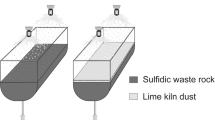Abstract
To control the environmentally detrimental impact of acid rock drainage, two different countermeasures, layers of acid-buffering materials and sodium dodecyl sulphate addition, were tested for their efficiency in laboratory percolation experiments. In the experiment with a layer of calcium bentonite, only the iron output was reduced. The experiments with layers of concrete grains demonstrated a decrease of the microbial activity as well as a precipitation of heavy-metal ions, whereas the cell numbers did not decrease. Furthermore, finely grained concrete (1–5 mm) formed a water-tight hardpan (self-sealing layer). In the experiment with 1 mM sodium dodecyl sulphate, all the microorganisms were killed and hence metal sulphide dissolution was stopped. With 0.1 mM sodium dodecyl sulphate only a short, transient inhibition of leaching was achieved. The bacteria remained alive.
Similar content being viewed by others
Author information
Authors and Affiliations
Additional information
Received: 16 February 1998 / Accepted: 23 February 1998
Rights and permissions
About this article
Cite this article
Schippers, A., Jozsa, PG. & Sand, W. Evaluation of the efficiency of measures for sulphidic mine waste mitigation. Appl Microbiol Biotechnol 49, 698–701 (1998). https://doi.org/10.1007/s002530051234
Issue Date:
DOI: https://doi.org/10.1007/s002530051234




